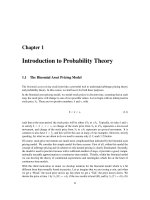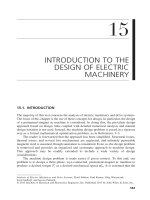CHAPTER THREE: INTRODUCTION TO PORTFOLIO THEORY pps
Bạn đang xem bản rút gọn của tài liệu. Xem và tải ngay bản đầy đủ của tài liệu tại đây (682.83 KB, 30 trang )
CHAPTER THREE: INTRODUCTION
TO PORTFOLIO THEORY
06/08/2011 1
8 - 2
Portfolios
• A portfolio is a collection of different securities such as stocks and bonds,
that are combined and considered a single asset
• The risk-return characteristics of the portfolio is demonstrably different
than the characteristics of the assets that make up that portfolio,
especially with regard to risk.
• Combining different securities into portfolios is done to achieve
diversification.
06/08/2011
8 - 3
Diversification
Diversification has two faces:
1. Diversification results in an overall reduction in portfolio risk (return
volatility over time) with little sacrifice in returns, and
2. Diversification helps to immunize the portfolio from potentially
catastrophic events such as the outright failure of one of the
constituent investments.
(If only one investment is held, and the issuing firm goes bankrupt,
the entire portfolio value and returns are lost. If a portfolio is made
up of many different investments, the outright failure of one is more
than likely to be offset by gains on others, helping to make the
portfolio immune to such events.)
06/08/2011
8 - 4
Expected Return of a Portfolio
Modern Portfolio Theory
The Expected Return on a Portfolio is simply the weighted average of
the returns of the individual assets that make up the portfolio:
The portfolio weight of a particular security is the percentage of the
portfolio’s total value that is invested in that security.
)(
n
1i
iip
ERwER
[8-9]
06/08/2011
8 - 5
Expected Return of a Portfolio
Example
Portfolio value = $2,000 + $5,000 = $7,000
r
A
= 14%, r
B
= 6%,
w
A
= weight of security A = $2,000 / $7,000 = 28.6%
w
B
= weight of security B = $5,000 / $7,000 = (1-28.6%)= 71.4%
%288.8%284.4%004.4
) %6(.714)%14(.286)(
n
1i
iip
ERwER
06/08/2011
8 - 6
Range of Returns in a Two Asset
Portfolio
In a two asset portfolio, simply by changing the weight of the
constituent assets, different portfolio returns can be achieved.
Because the expected return on the portfolio is a simple weighted
average of the individual returns of the assets, you can achieve
portfolio returns bounded by the highest and the lowest individual
asset returns.
06/08/2011
8 - 7
Modern Portfolio Theory - MPT
• Prior to the establishment of Modern Portfolio Theory (MPT), most
people only focused upon investment returns…they ignored risk.
• With MPT, investors had a tool that they could use to dramatically reduce
the risk of the portfolio without a significant reduction in the expected
return of the portfolio.
06/08/2011
8 - 8
Expected Return and Risk For
Portfolios
Standard Deviation of a Two-Asset Portfolio using Covariance
))()((2)()()()(
,
2222
BABABBAAp
COVwwww
[8-11]
Risk of Asset A
adjusted for weight
in the portfolio
Risk of Asset B
adjusted for weight
in the portfolio
Factor to take into
account comovement of
returns. This factor can
be negative.
06/08/2011
8 - 9
Expected Return and Risk For
Portfolios
Standard Deviation of a Two-Asset Portfolio using Correlation Coefficient
))()()()((2)()()()(
,
2222
BABABABBAAp
wwww
[8-15]
Factor that takes into
account the degree of
comovement of returns. It
can have a negative value
if correlation is negative.
06/08/2011
8 - 10
Grouping Individual Assets into
Portfolios
• The riskiness of a portfolio that is made of different risky assets is a
function of three different factors:
– the riskiness of the individual assets that make up the portfolio
– the relative weights of the assets in the portfolio
– the degree of comovement of returns of the assets making up the portfolio
• The standard deviation of a two-asset portfolio may be measured using
the Markowitz model:
BABABABBAAp
wwww
,
2222
2
06/08/2011
8 - 11
Risk of a Three-Asset Portfolio
The data requirements for a three-asset portfolio grows dramatically if
we are using Markowitz Portfolio selection formulae.
We need 3 (three) correlation coefficients between A and B; A and C;
and B and C.
A
B
C
ρ
a,b
ρ
b,c
ρ
a,c
CACACACBCBCBBABABACCBBAAp
wwwwwwwww
,,,
222222
222
06/08/2011
8 - 12
Covariance
• A statistical measure of the correlation of
the fluctuations of the annual rates of
return of different investments.
)-)((Prob
_
,
1
_
,i BiB
n
i
iiAAB
kkkkCOV
[8-12]
06/08/2011
8 - 13
Correlation
• The degree to which the returns of two stocks co-move is
measured by the correlation coefficient (ρ).
• The correlation coefficient (ρ) between the returns on two
securities will lie in the range of +1 through - 1.
+1 is perfect positive correlation
-1 is perfect negative correlation
BA
AB
AB
COV
[8-13]
06/08/2011
8 - 14
Covariance and Correlation Coefficient
• Solving for covariance given the correlation
coefficient and standard deviation of the two
assets:
BAABAB
COV
[8-14]
06/08/2011
8 - 15
Importance of Correlation
• Correlation is important because it affects the degree to
which diversification can be achieved using various assets.
• Theoretically, if two assets returns are perfectly positively
correlated, it is possible to build a riskless portfolio with a
return that is greater than the risk-free rate.
06/08/2011
8 - 16
Diversification of a Two Asset Portfolio
Demonstrated Graphically
The Effect of Correlation on Portfolio Risk:
The Two-Asset Case
Expected Return
Standard Deviation
0%
0%
10%
4%
8%
20% 30% 40%
12%
B
AB
= +1
A
AB
= 0
AB
= -0.5
AB
= -1
06/08/2011
8 - 17
Impact of the Correlation Coefficient
• Figure 8-7 (see the next slide) illustrates the
relationship between portfolio risk (σ) and the
correlation coefficient
– The slope is not linear a significant amount of
diversification is possible with assets with no
correlation (it is not necessary, nor is it possible to
find, perfectly negatively correlated securities in the
real world)
– With perfect negative correlation, the variability of
portfolio returns is reduced to nearly zero.
06/08/2011
8 - 18
Expected Portfolio Return
Impact of the Correlation Coefficient
8 - 7 FIGURE
15
10
5
0
Standard Deviation (%) of
Portfolio Returns
Correlation Coefficient (ρ)
-1 -0.5 0 0.5 1
8 - 19
Zero Risk Portfolio
• We can calculate the portfolio that
removes all risk.
• When ρ = -1, then
• Becomes:
BAp
ww
)1(
[8-16]
))()()()((2)()()()(
,
2222
BABABABBAAp
wwww
[8-15]
06/08/2011
8 - 20
Efficient Frontier
The Two-Asset Portfolio Combinations
A is not attainable
B,E lie on the
efficient frontier and
are attainable
E is the minimum
variance portfolio
(lowest risk
combination)
C, D are attainable
but are dominated by
superior portfolios
that line on the line
above E
8 - 10 FIGURE
Expected Return %
Standard Deviation (%)
A
E
B
C
D
06/08/2011
8 - 21
Efficient Frontier
The Two-Asset Portfolio Combinations
8 - 10 FIGURE
Expected Return %
Standard Deviation (%)
A
E
B
C
D
Rational, risk
averse
investors will
only want to
hold portfolios
such as B.
The actual
choice will
depend on
her/his risk
preferences.
06/08/2011
06/08/2011 22
Diversification
Risk, Return and Portfolio Theory
06/08/2011 23
8 - 24
Diversification
• We have demonstrated that risk of a portfolio can be reduced by
spreading the value of the portfolio across, two, three, four or more
assets.
• The key to efficient diversification is to choose assets whose returns
are less than perfectly positively correlated.
• Even with random or naïve diversification, risk of the portfolio can
be reduced.
– This is illustrated in Figure 8 -11 and Table 8 -3 found on the following
slides.
• As the portfolio is divided across more and more securities, the risk of the
portfolio falls rapidly at first, until a point is reached where, further
division of the portfolio does not result in a reduction in risk.
• Going beyond this point is known as superfluous diversification.
06/08/2011
8 - 25
Diversification
Domestic Diversification
8 - 11 FIGURE
14
12
10
8
6
4
2
0
Standard Deviation (%)
Number of Stocks in Portfolio
0 50 100 150 200 250 300
Average Portfolio Risk
January 1985 to December 1997
06/08/2011









